Brassicaceae
Mustard family
Herbs
- Flowers perfect, cruciform (cross- or X-shaped). Sepals 4, free. Petals 4, free, clawed. Stamens 6 with the 2 outer stamens shorter than the 4 inner stamens. Pistil compound, ovary superior, carpels 2.
- Fruit a silique or silicle.
- Leaves simple or compound (pinnate), alternate, without stipulates.
About 350 genera and 3,000 species, primarily North Temperate.
The Brassicaceae is the 4th largest family in B.C., with 169 species and varieties. The family is very important economically, providing mustard, cabbage, broccoli, cauliflower, turnips, rapeseed or canola (all species or varieties of Brassica), radish (Raphanus), horseradish (Cochlearia), and watercress (Rorippa). Numerous genera are cultivated as ornamentals, including Lobularia (sweet alyssum), Matthiola (stocks), and Aubrieta.
Flowers
| Brassica – mustardThis family is pretty easy to identify. The flowers have four petals in a cross-type of arrangement. |
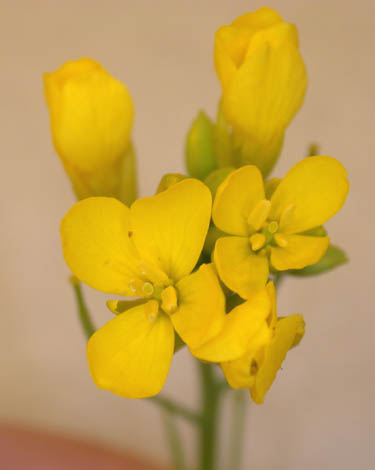 Mustard flower |
| Here is a longitudinal section through a flower. The stamens are didynamous (have stamens in two pairs of unequal length). Can you see that in this picture? |
 Longitudinal Section Through a Mustard Flower |
| ..if not here is a picture that indicates with arrows the four long and the two short ones. |
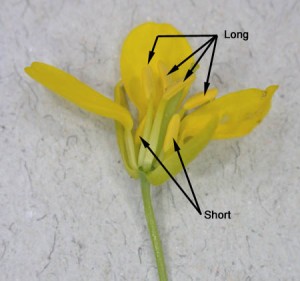 Longitudinal Section Through a Mustard Flower |
|
Eruca sativa – Arugula
The greens of this plant are a trendy salad ingredient. It has a very distinctive flavour. |
 Arugula Flower |
| Here is the face view of a flower which looks like an “X”.. |
 Arugula Flower, Front View |
| This sideview shows the calyx (indicated with an arrow). |
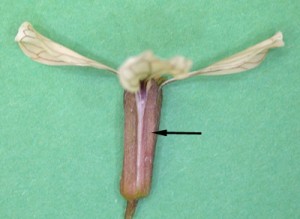 Arugula Flower, Side View |
| Closer….. |
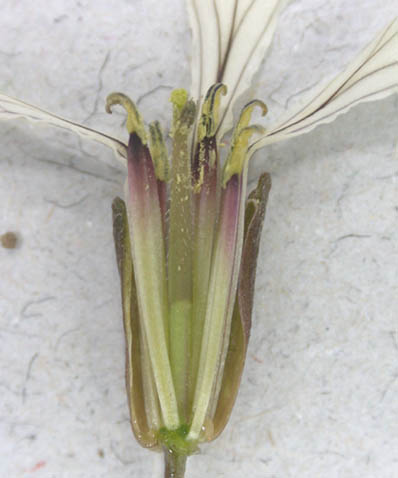 Longitudinal Section Through an Arugula Flower, Close Up |
| The petals in this family have a characteristic bend. The claw is the lower portion of the petal which is indicated with an arrow in the picture below. |
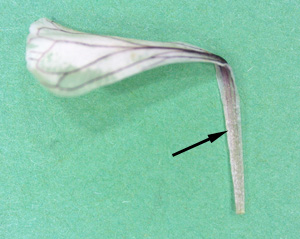 Arugula Flower, Bent Petal |
| A cross-section of the ovary reveals two carpels. You can see a partition that separates the two carpels (indicated with an arrow). This partition is called a replum and is actually an extension of the placenta. You can also see two developing seeds within this ovary. |
 Cross Section of the Ovary, Arugula |
Fruits
The fruits are silicles or siliques. (Silicle: a dry fruit from a two-carpet pistil in the two valves split away from a partition (replum). It is not more than three times long as wide).
|
Lunaria annua – money plant
These are the immature fruits of the money plant. |
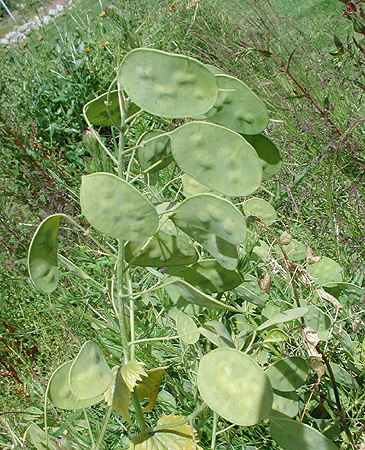 Immature Fruits of the Lunaria Plant |
| The fruits are short (less than three times long as wide) and are therefore called silicles. |
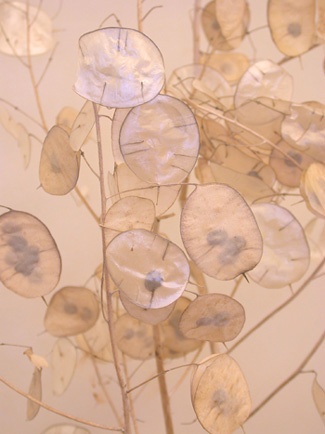 Fruits of Lunaria |
| Here is a picture of a silicle taken apart and labeled. The replum is between the two valves. |
 Lunaria Fruit, Pulled Apart |
| Capsella bursa-pastoris – Shepherd’s purse |
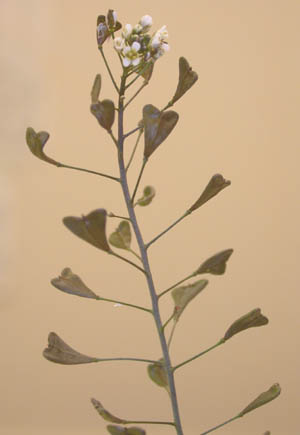 Sheperd’s Purse |
| The fruit is cuneate-obcordate (shaped like a triangle with a notch in the top). |
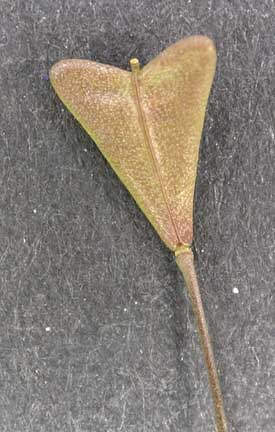 Fruit of Sheperd’s Purse |
| Here one valve is broken away and you can see the seeds. The fruit is obcompressed, that is it is compressed at right angles to the replum. |
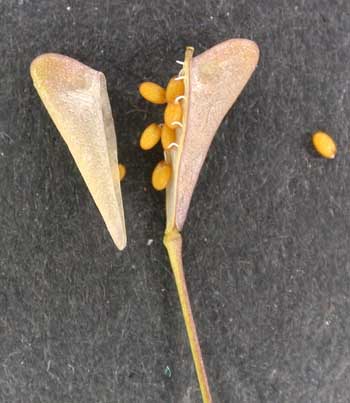 Fruit of Sheperd’s Purse |
| Both valves have been removed to show the long narrow replum. |
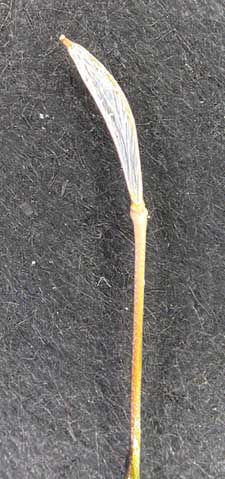 Fruit of Sheperd’s Purse, Valves Removed |
A silique is a dry fruit derived from a two-carpetl pistil in the two valves split away from a partition (replum). It is more than three times long as wide.
| Raphanus – radish. Most of us harvest our radishes before they get a chance to flower. If left the plants can get quite large. |
 Radish Flower |
| The flowers are characteristic of this family. |
 Radish Flower |
| Here is an immature fruit. You can see that it is more than three times long as wide. It is therefore a silique. |
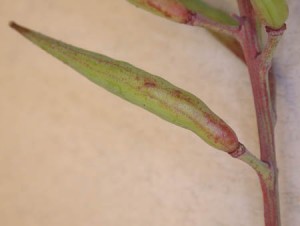 Immature Fruit of a Radish |
| The longitudinal section shows that the ovules are uniseriate (in one row). |
 Longitudinal Section of a Radish Fruit |
| Brassica – mustard. The fruits of this plant are also siliques. |
 Fruits of Brassica |
| Here is a longitudinal section through the fruit. Here you can see that there is a beak-like end to this fruit (indicated with an arrow). |
 Longitudinal Section Through a Brassica Fruit |
| A closer look. This is still considered uniseriate because the ovules alternate along the length of the silique. Note the replum indicated with an arrow. |
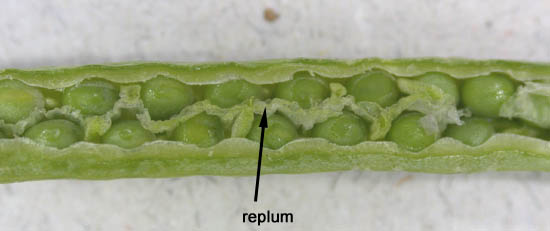 Longitudinal Section, Brassica Fruit |
| Eruca sativa – arugula. Remember our friend Arugula? |
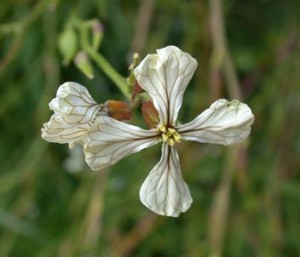 Arugula Flower |
| It also has siliques. |
 Fruit of Arugula – Silique |
| Here you can see that this fruit has a pronounced beak. |
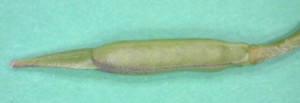 Pronounced Beak of the Arugula Fruit |
| This longitudinal section shows the biseriate nature of the ovules. |
 Arugula Silique, Longitudinal Section |
Other Members of Brassicaceae
| Brassica oleracea. Many of our favourite vegetables are variations on this species. These include cauliflower, broccoli, kohlrabi, kale, Brussels sprouts, and of course the ever-so-famous cabbage. |
 Cabbage Plant |
| Brocolli we eat is actually a very dense flower head. What happens if you leave it too long in your fridge? It blooms! |
 Broccoli Flower Head |
| It is the stem of the kohlrabi which is modifed. |
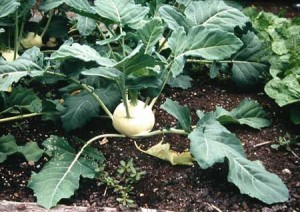 Kohlrabi Plant |
| …and this is everyones favourite. A little immature, but give ’em a month! |
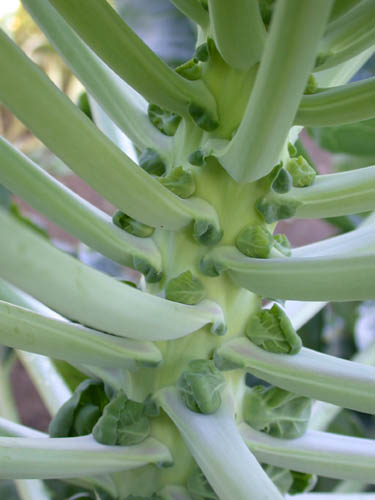 Brussel Sprouts |
| A great place to find a wide variety of cruciferous vegetables in the Asian markets. In the picture below most of the produce is from the Brassicaceae. |
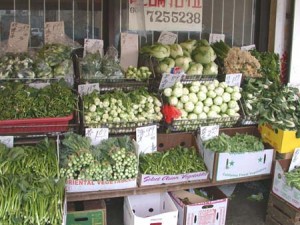 Market |
| These long radishes (daikon) originated in Mediterranean Europe. It is a variation on our garden radish, Raphanus sativus. Daikon is commonly eaten in Asian cuisine. It is sweet and less bitter than the garden radish. |
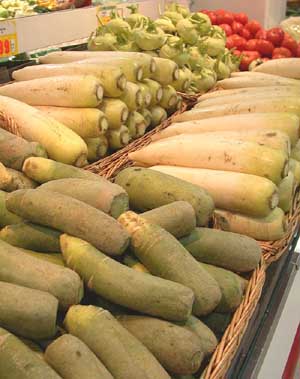 Daikon |
Back to Lab 3

































